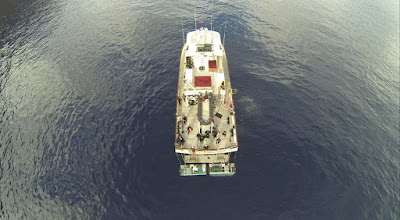47 meters down, review by Cindy Michaels
Shark Diver’s Communications Director, Cindy Michaels is not just the heart and soul of our company, she’s also a former writer, broadcaster, news director and professional movie reviewer.
Her review of 47 Meters Down combines her experience from her previous work, with the knowledge she has about the subject matter of the movie, Shark Diving.
Enjoy her review!
Cheers,
Martin
By Cindy Michaels,
Before I begin my informative rant about the movie 47 Meters Down, keep in mind that the film was originally only meant for a 2016 DVD release under the name In the Deep. (My grandmother always said, “leave well enough alone.” Apparently, they didn’t listen to my g-ma.) A film company bought the rights, recalled the DVDs, and it was unfortunately released on the big screen. But some DVD copies that had already been distributed to retailers landed in the hands of the public. So if it becomes a cult classic, those DVD holders may be able to make an extra buck for owning a collector’s item. My suggestion… recycle at your local redemption center.
The movie: I laughed; and frustratingly so. Mandy ‘Moan’ Moore stars in this unrealistic film about two sisters that venture to Mexico for a little R and R. The girls get sweet-talked by a couple of local guys into taking a shark dive in a surface cage. Now, I would normally say…”good move, guys!” But the boat was rusty, rickety, and run by a scruffy Captain Taylor, played by Matthew Modine. Ohhhh Matt.
Anyway, things go horribly wrong and the cage drops 47 meters down. Yada yada yada. That’s 154 feet! Have any of you dived that far down? If so, you know your dive time changes dramatically; air is used 4.7 times faster at that level. But for Kate and Lisa, or rather the writers of this mess, no rules apply. The girls are having conversation, hugging each other, and yes, Mandy Moore cannot stop moaning. They just would not have had the time to do all that. One intake from all her crying would have used up the air she had left. And for the amount of times each of them tried to swim to the surface but were told to go back down to the cage…seriously? If you’ve already gone half way, keep swimming! Just keep swimming. Just keep swimming.
I ponder this one. Why did all the guys that took them on this venture hang around topside with spear guns, waiting for the girls to be rescued by the Coast Guard? If Kate and Lisa make it to the top, there’s NO WAY the boys are getting another date! “Hello, Mr. Coast Guard man, what’s your name?” And where are the big beautiful great whites? There really weren’t that many in this film. Clearly Bruce or Lucy would have said ‘hello.’ They must have found more entertaining places to swim, like Guadalupe Island, chatting it up with our divers!
Ok, for those of you (and there’s got to be at least 1) who are a tad bit apprehensive about cage diving, after nervously sitting through 47 Meters Down, let me reassure you of some vital things.
Our cages are awesome! They are reinforced with floatation material bolted to the INSIDE and indestructible, water-tight dock floats secured to the outside; four on each cage. The cages are tied together and then attached to the boat at 3 points by chains and lines.
 |
| our surface cages are attacked to the vessel |
My friend, the cages are secure; they are basically an extension of the boat.
And just for giggles, I’ll tell you this. If our crew was in that movie, they would have jumped overboard to save Kate and Lisa with their bare hands, strong arm muscles, and fearless attitudes! All would be safely brought on board OUR VESSEL, just in time for a lovely sit-down dinner specially prepared by our fabulous chefs, Mark and Shay.
So, please don’t let Mandy Moore moan you into being afraid of cage diving with us. It is an incredible experience where we INVITE shark folk, like Bruce, Lucy, Chugey, Scarboard and the rest of our fishy friends, to come say ‘hi.’ If they were willing, we’d invite them to dinner. Mark! Prepare the tuna!
~Shark Diver has been diving with great white sharks for 16 years with a 100% safety record. Our great white shark diving season at Isla Guadalupe, Mexico runs from August-November. We take 18 divers per trip and treat our guests to 3 meals a day, unlimited snacks, beer and wine, a comfy bed and fluffy pillow, and lots of excitement. Dive equipment provided, no certification necessary, shark-sighting guaranteed. We love the sharks and you will too. Come dive with us! www.SharkDiver.com
Let’s go Shark Diving!
About Shark Diver. As a global leader in commercial shark diving and conservation initiatives Shark Diver has spent the past decade engaged for sharks around the world. Our blog highlights all aspects of both of these dynamic and shifting worlds. You can reach us directly at staff@sharkdiver.com.







